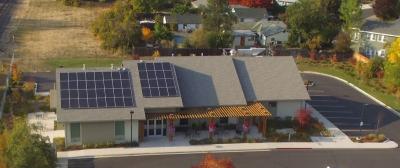Conservation
Harvesting Talent's Energy
Project Description
In the fall of 2017, True South Solar installed a 15.7 kW solar power system on the roof of the Talent Community Center in Talent, Oregon. The project features SunPower E20 solar panels, state-of-the-art commercial panels that produce 20% more power per watt when compared to the conventional standard technology. The system is estimated to produce 21,346 kilowatt hours (kWh) which equates to just over 85% of the building’s annual energy demand. Over the 25-year period following the installation savings on the Community Center’s utility bills will equate to nearly $102,000. The City of Talent is committed to reducing its carbon footprint, and this project is just one of many steps that the City will take to realize that commitment.
The project would not have been possible without the generous grant award from Pacific Power’s Blue Sky Renewable Energy program which provided 88% of the installment’s required funding! The City committed to financing the remaining 12% of the project’s cost. Blue Sky projects are chosen from a competitive pool of applicants each year and the Talent Community Center project qualified as a worthy recipient of award for the 2016 grant cycle. Funding for Blue Sky awards are provided by Pacific Power utility customers who pay as little as $1.95 each month on top of their bill. With great pride, the City of Talent has one of the highest enrollment rates in the state of Oregon at over 20 percent of residents!
Project Partners
- Financier: Pacific Power’s Blue Sky Renewable Energy program
- Client: City of Talent
- Skills: True South Solar
- Outspoken support: Rogue Climate
Explaining the data
To better understand the live information above, the difference between power and energy needs to be addressed.
- “PV Energy”, the number of watt-hours (Wh) tells us how much energy from the sun is currently being absorbed and used within the building for the lights and heat.
- “Current PV Power” describes how much of that energy can be delivered at any given moment.
- "Watt" (W) represents the system’s ability to deliver the solar energy to the building’s electrical system at any one moment in time. This changes throughout the day due to the presence of clouds overhead. The Watt-hours describe how much energy has been derived from the sun today.
- “CO2 Avoided” is an effective way to illustrate the impact of the solar panels. Carbon dioxide is one of the main byproducts of producing energy from traditional, non-renewable sources such as coal and natural gas. Gathering energy from the sun does not produce carbon dioxide emissions and is therefore a much cleaner way to generate energy giving respect to the environment along the way!

